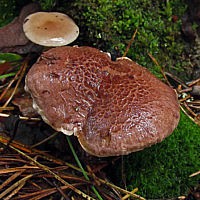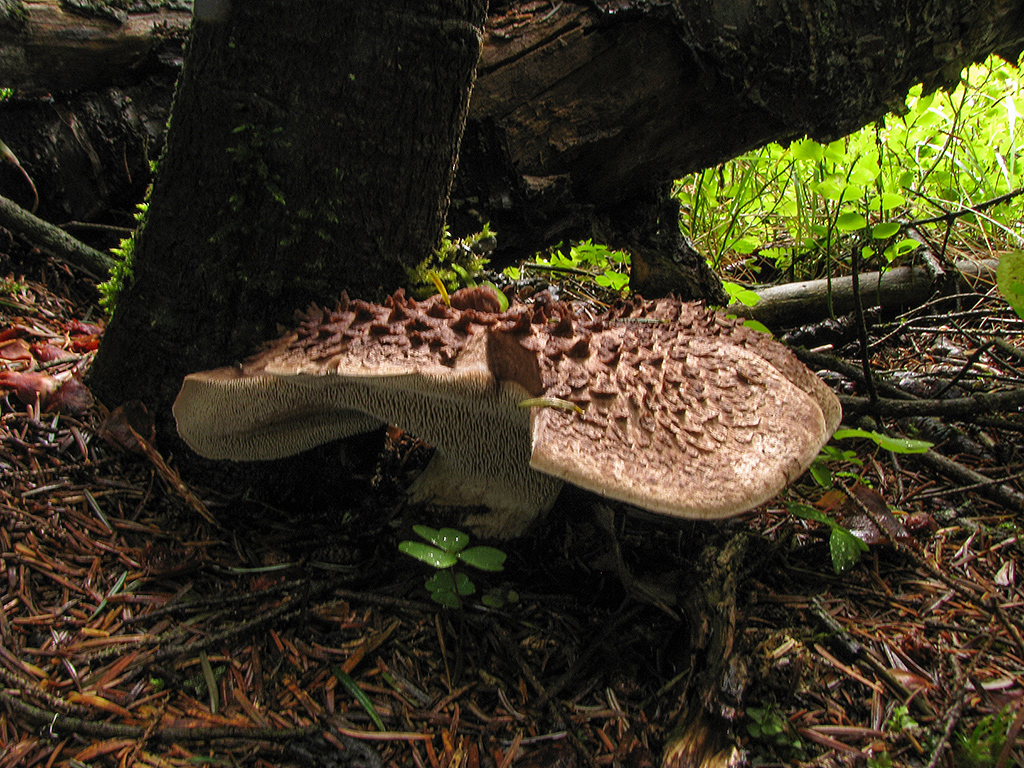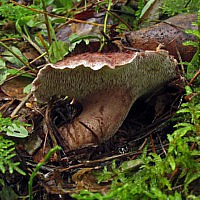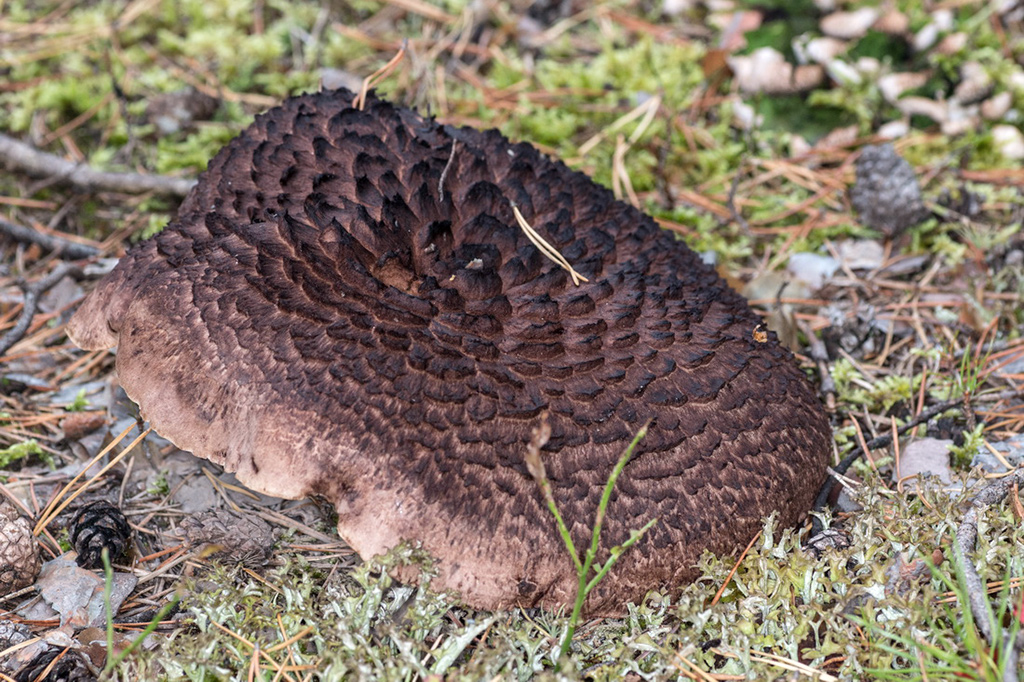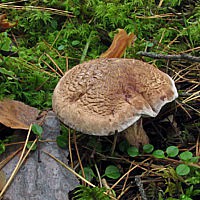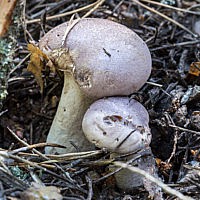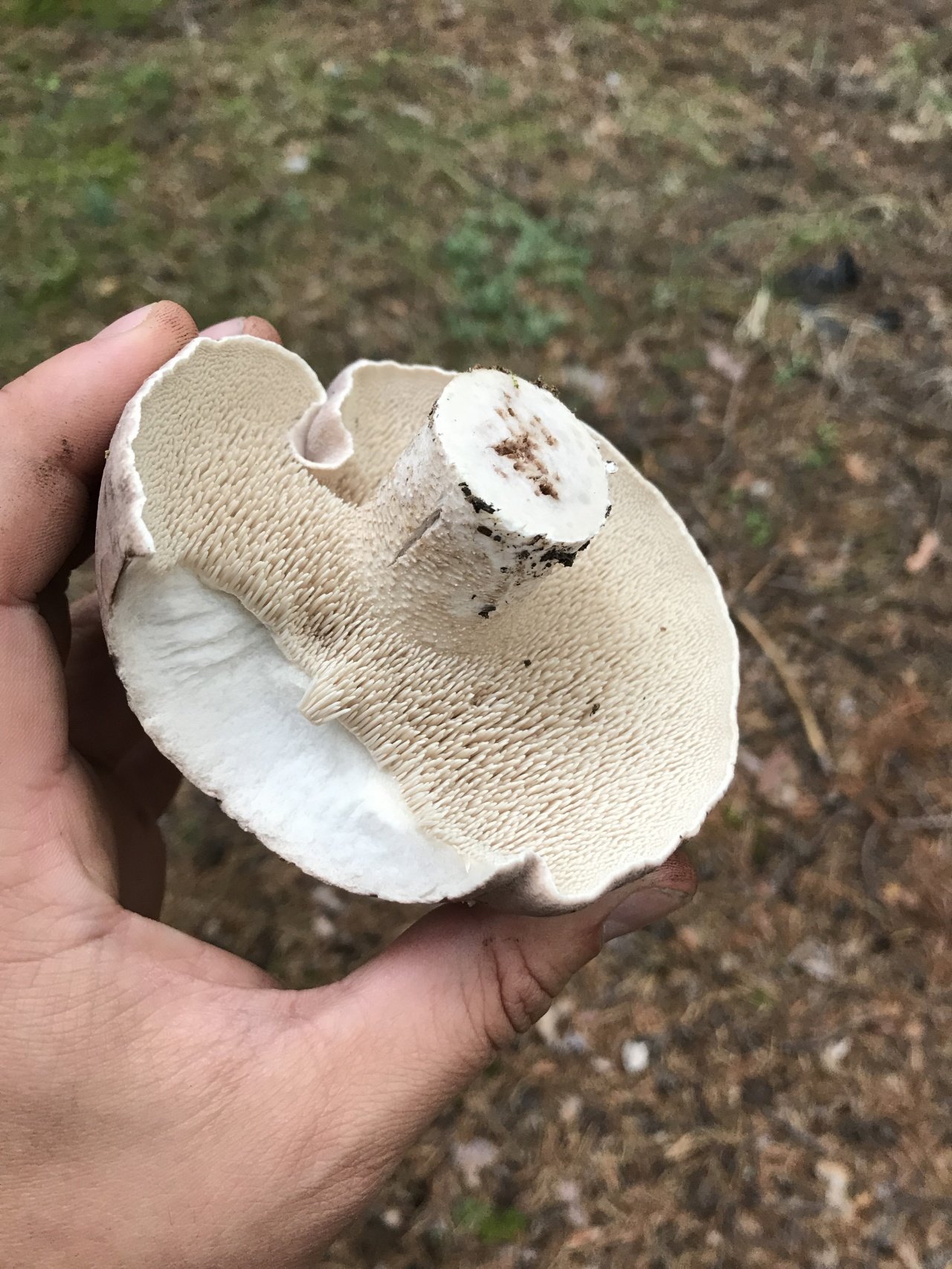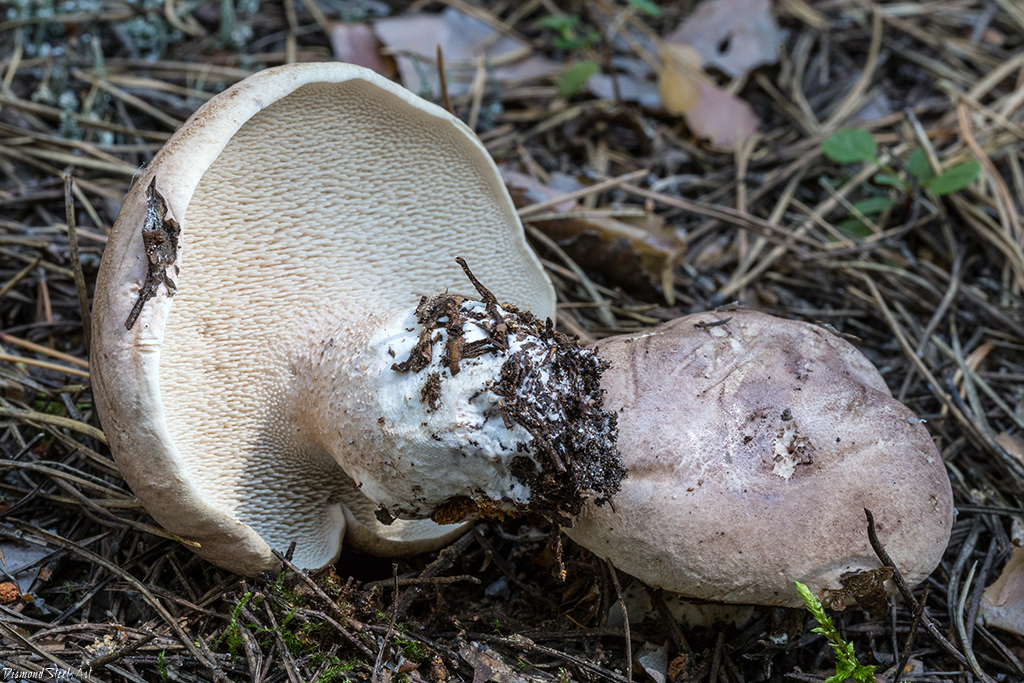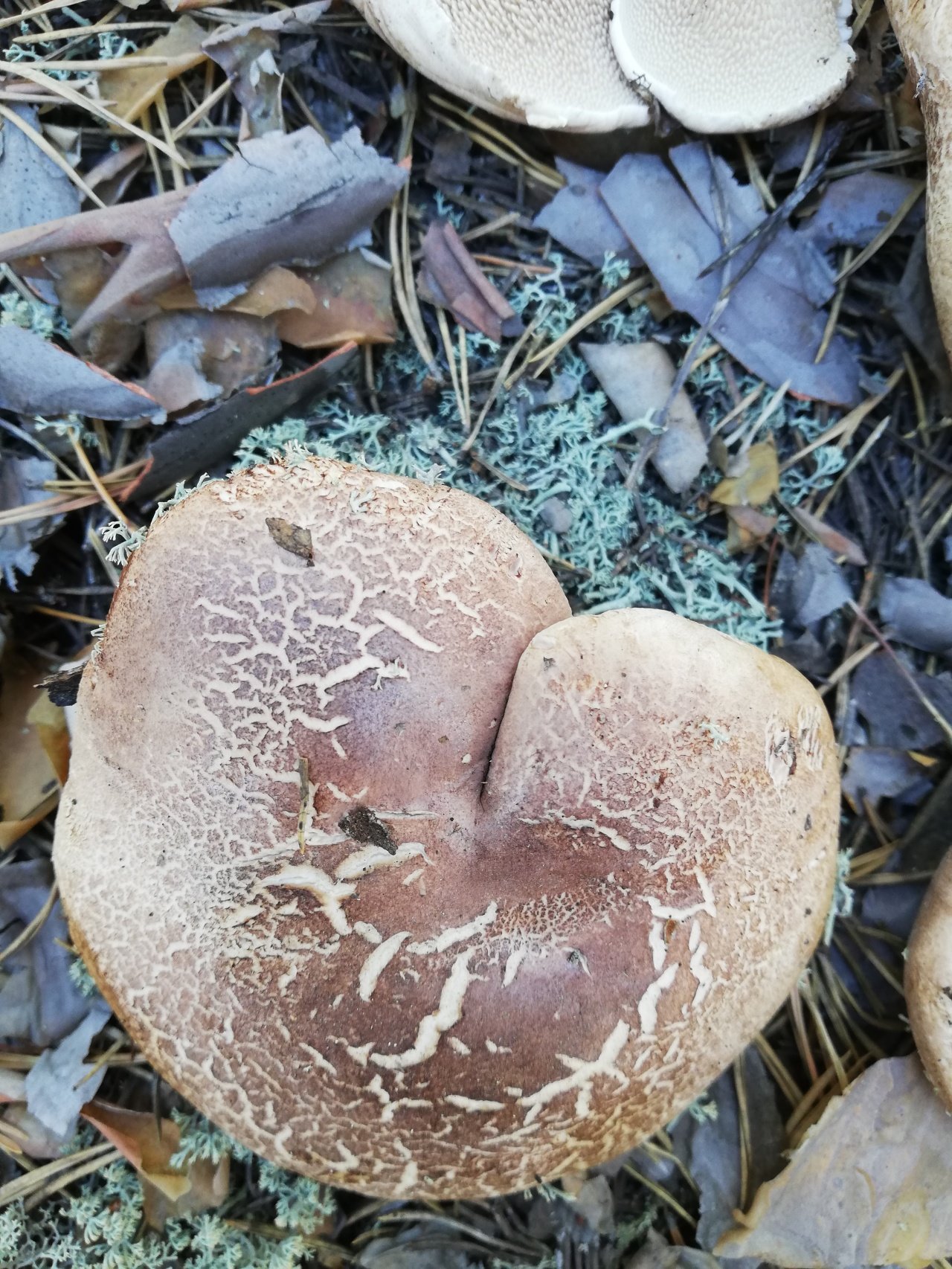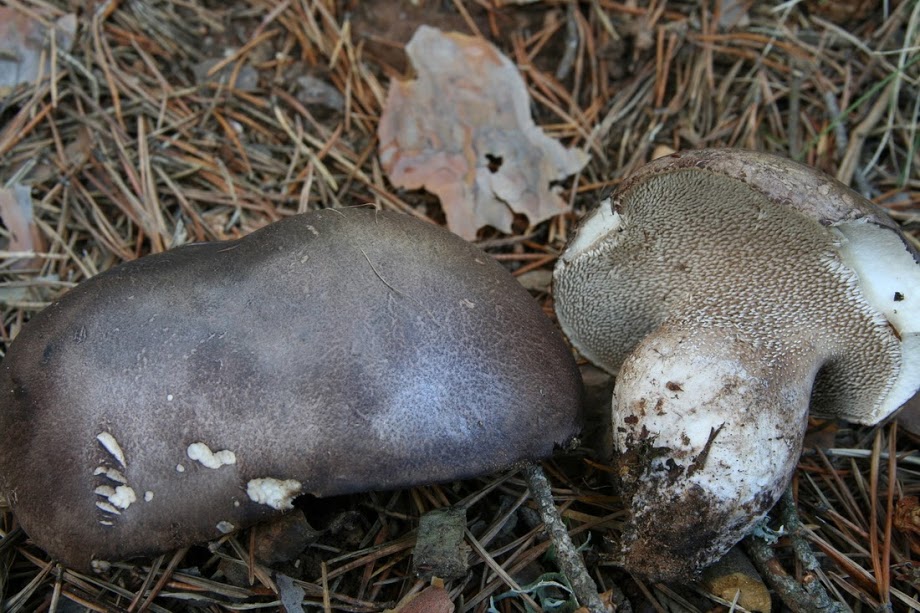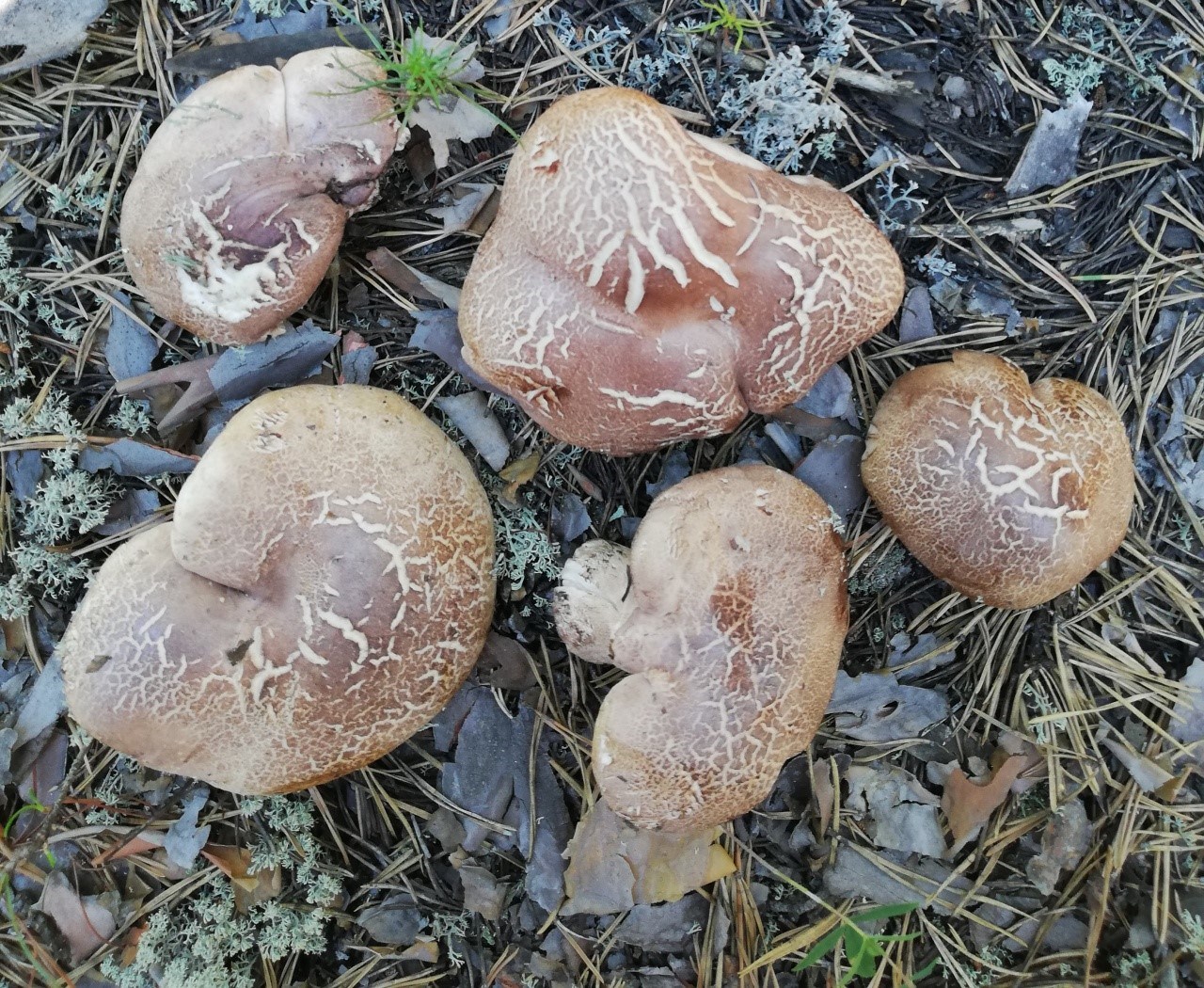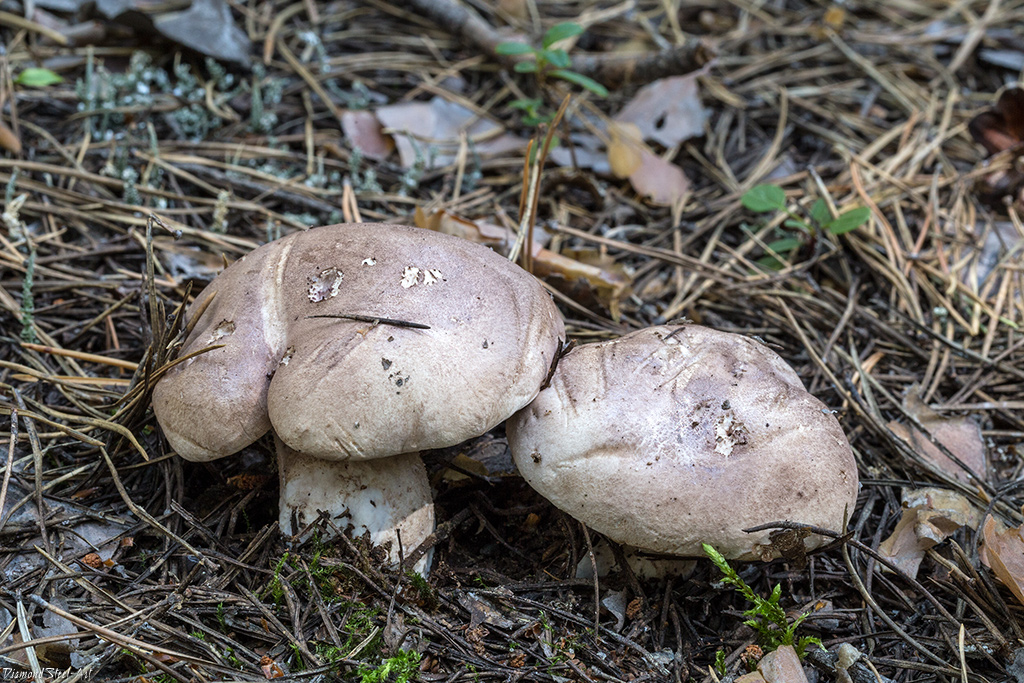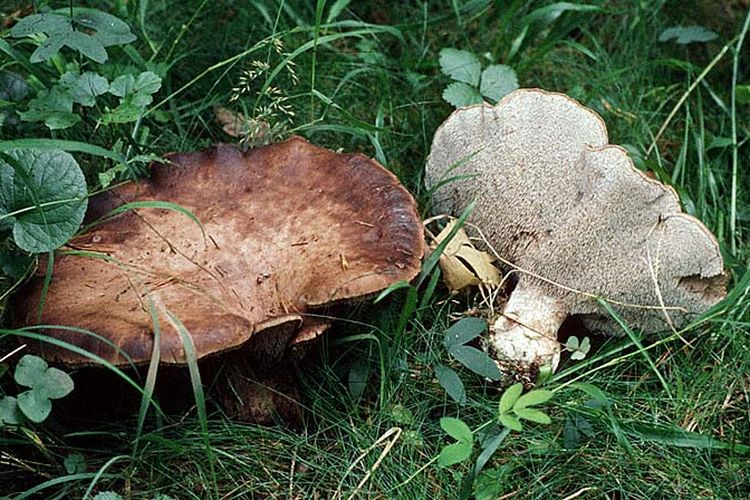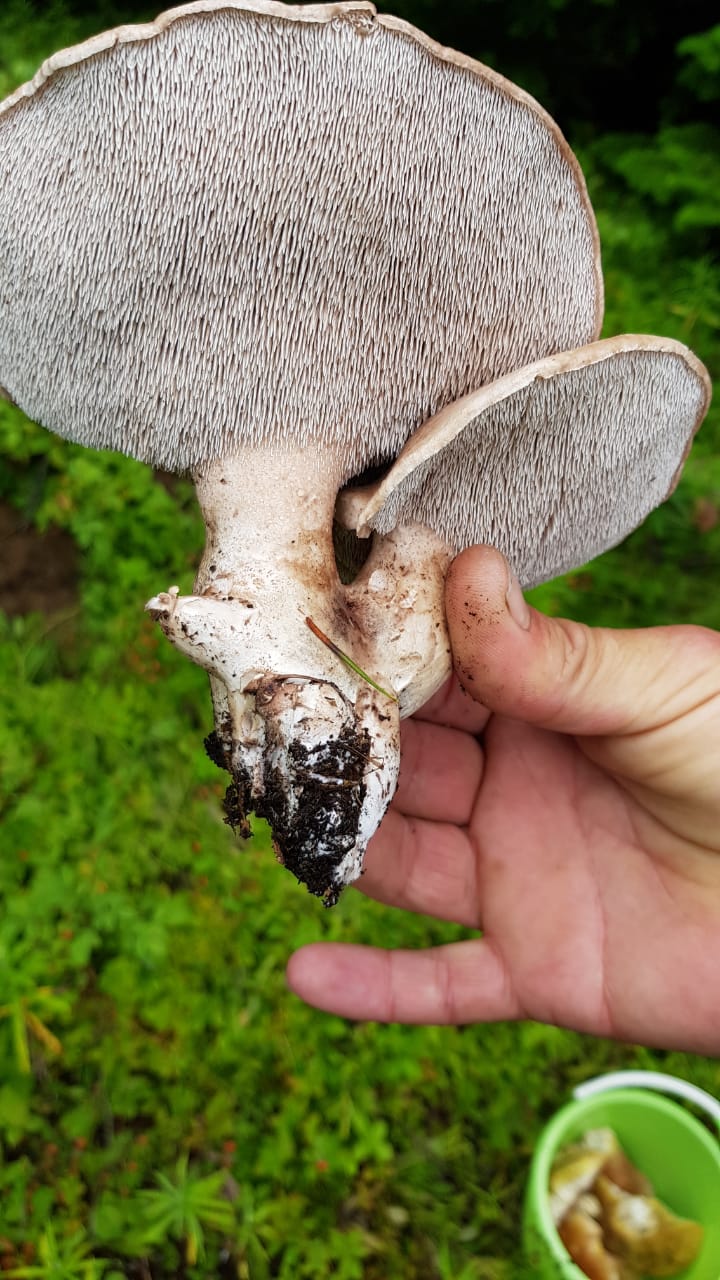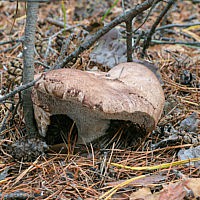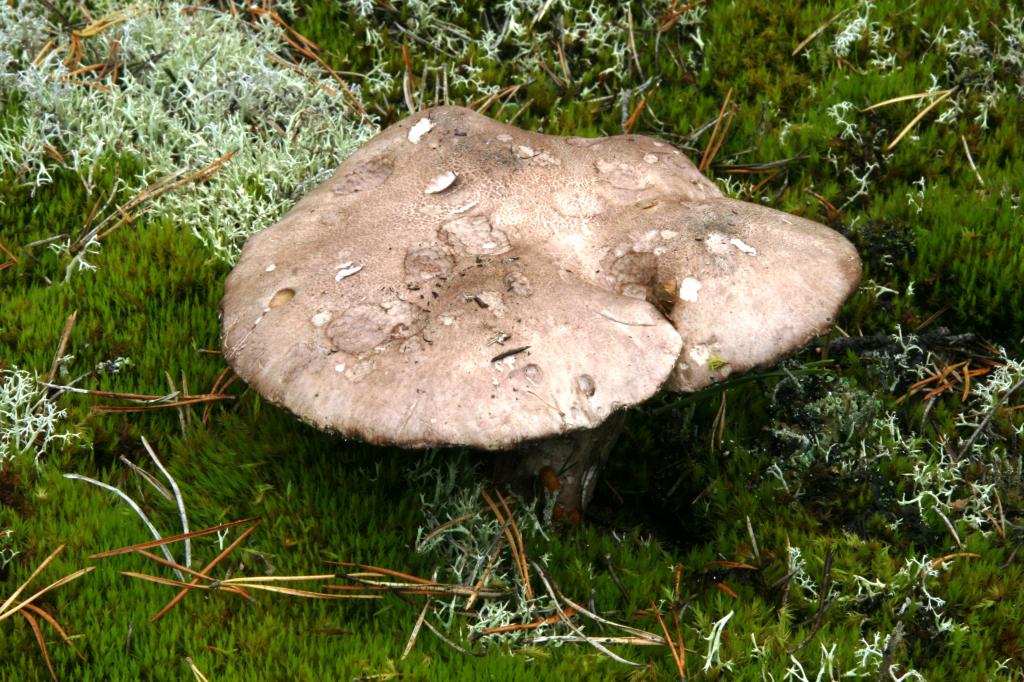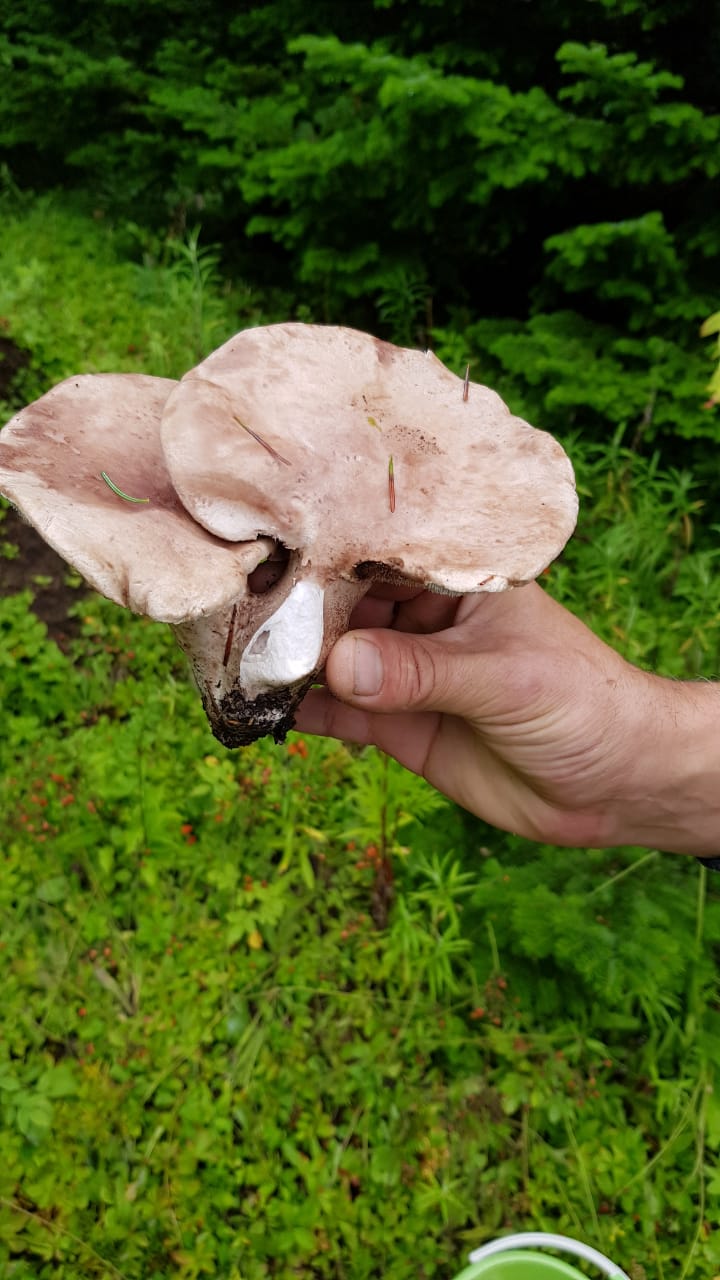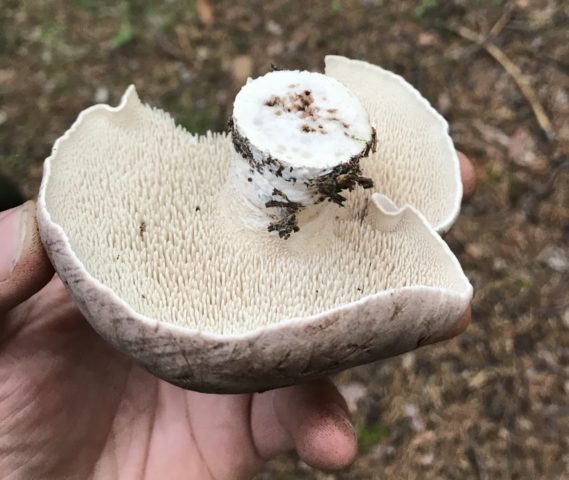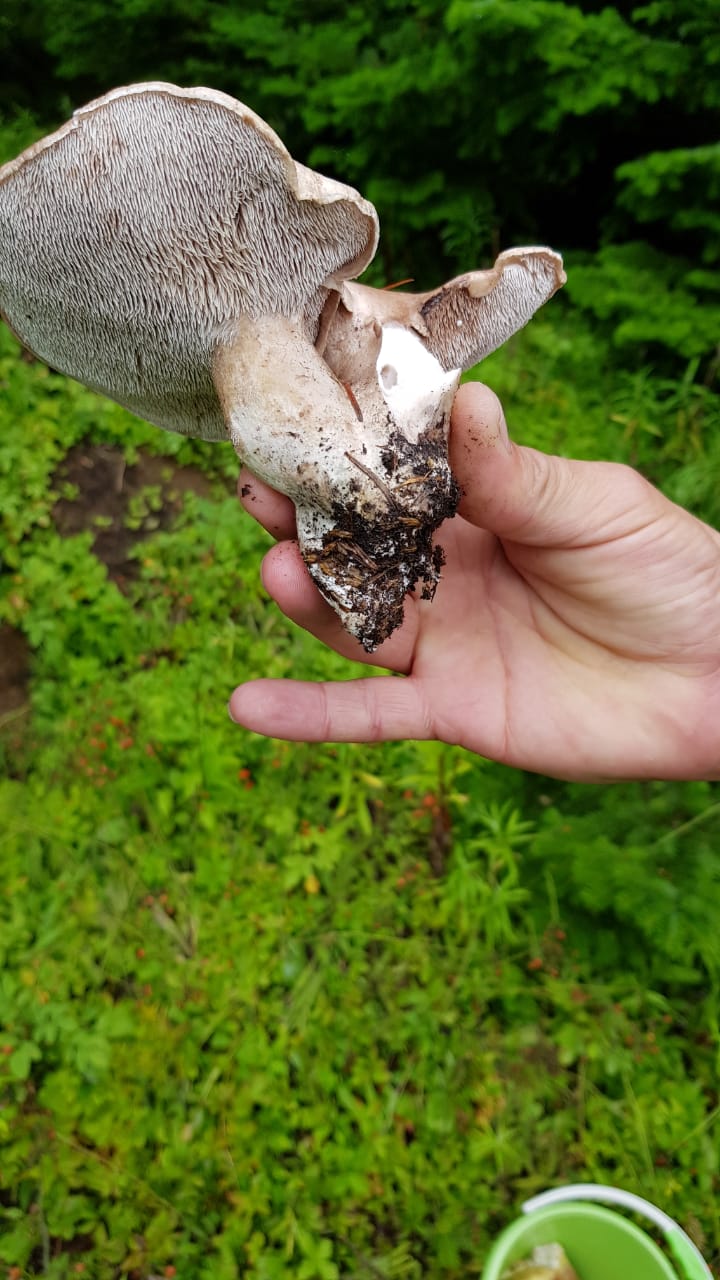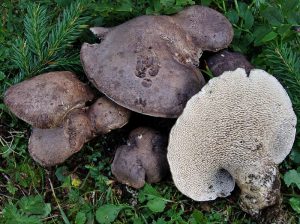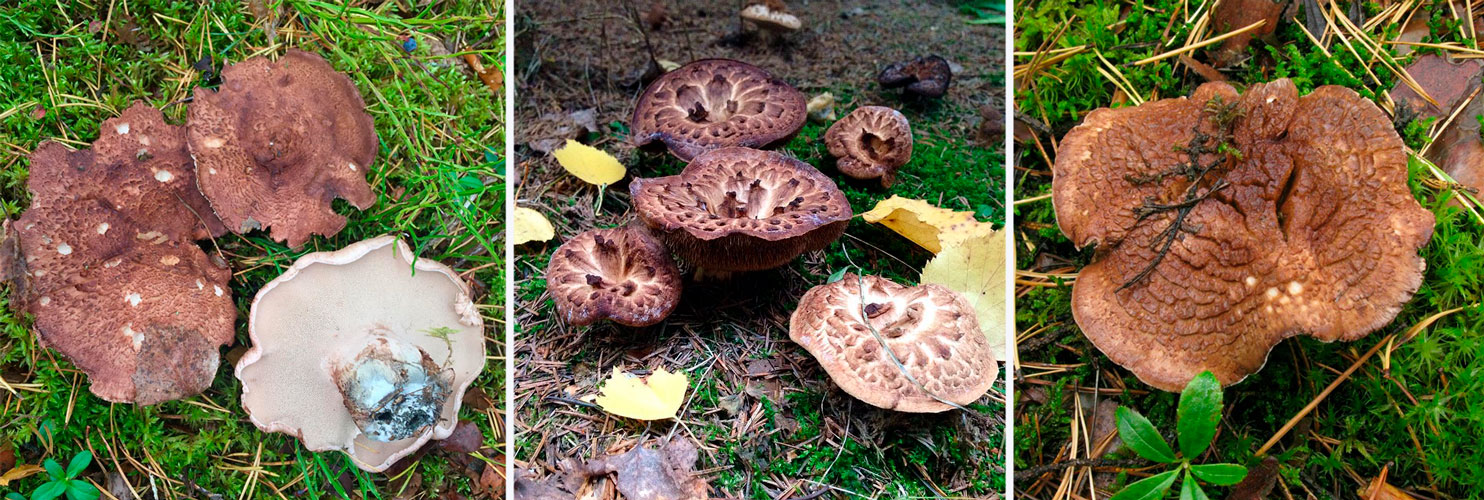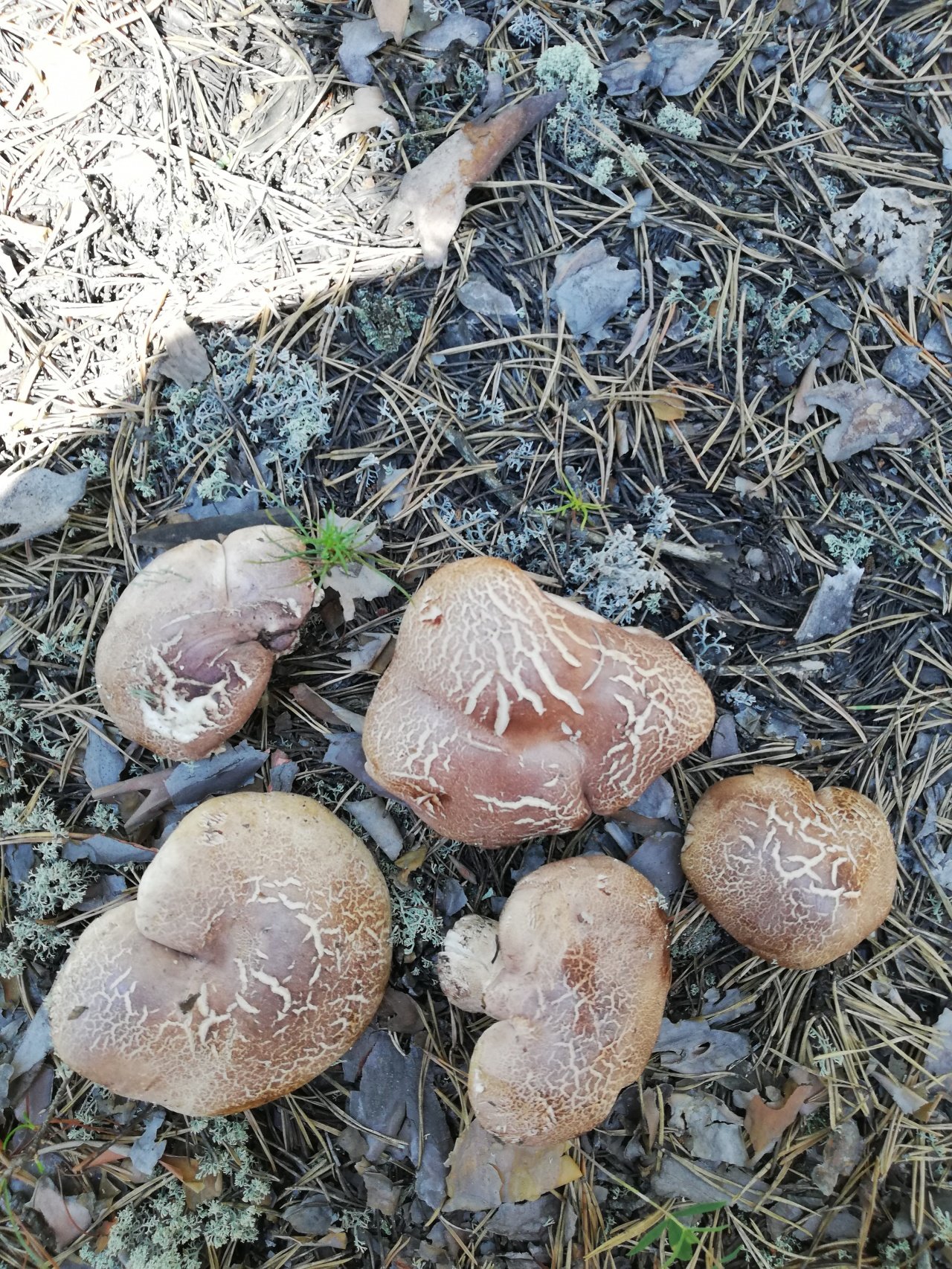Variegated sarcodon (Sarcodon Imbricatus)
- Other names for the mushroom:
- Hericium is variegated
- Hericium scaly
Synonyms:
- Hericium tiled
- Hericium scaly
- Sarcodon tiled
- Variegated sarcodon
- Kolchak
- Sarcodon squamosus
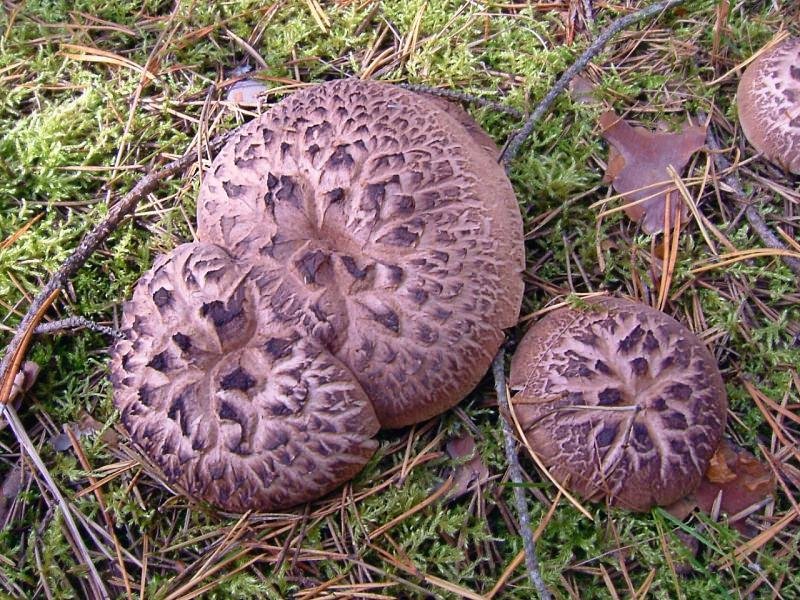
Hat: at first the hat is flat-convex, then it becomes concave in the middle. In diameter 25cm. Covered with tiled lagging brown scales. Velvety, dry.
Flesh: thick, dense, whitish-gray in color with a spicy odor.
Disputes: on the underside of the cap there are densely spaced conical spines, pointed thin, about 1 cm long. At first, the thorns are light, but with age they become darker.
Spore powder: brown.
Leg: 8 cm long. 2.5 cm thick. Solid, smooth cylindrical shape of the same color with a cap or slightly lighter. Sometimes there are specimens with a purple stem.
Distribution: Variegated sarcodon is found in coniferous forests growing in August - November. A rather rare mushroom that grows in large groups. Prefers dry sandy soils. Distributed in all forest zones, but not equally, in places it is absent altogether, and in places it forms circles.
Similarity: Variegated sarcodon can only be confused with similar species of hedgehogs. Related species:
- Finnish Hericium, characterized by the absence of large scales on the cap, dark pulp in the stem and an unpleasant, bitter or peppery taste
- Hericium is rough, which is slightly smaller than motley, with a bitter or bitter aftertaste and, like the Finnish, dark flesh in the leg.
Edible: The mushroom is good for human consumption. Young mushrooms can be eaten in any form, but tastes best when fried. The bitter taste disappears after boiling. Variegated sarcodon has an unusual spicy smell, so not everyone will like it. Most often, it is used as a condiment in small quantities.
Video about the mushroom Sarkodon motley:
Remarks: Sarcodon imbricatus grows in the darkest and most inaccessible places on dry sandy soils.
Leena Riihelä, a super-master at dyeing wool with natural dyes, writes on her blog:
Here on WikiMushroom, Sarcodon squamosus is spelled out the old fashioned way, as a synonym for Sarcodon imbricatus. For the time being, these barnacles remain to be defined as one species, since the exact definition will be extremely difficult, and from a culinary point of view, there is not much difference.
Is the hedgehog mushroom edible and its description (+30 photos)?
The black man's mane, popular in Russian latitudes, is not a separate mushroom, but a generalized name for a group of mushrooms, which are similar to each other in the specific structure of the hymenophore, which carries a spore-bearing layer on the inner surface of the cap. But, despite the external similarity, they only conditionally belong to the same group and are representatives of different genera and families.
Characteristic features and species similarities of hedgehogs
From above, hedgehogs often resemble chanterelles and can also grow in large colonies - from the photo with the description, you can get acquainted in more detail with each of the species of these mushrooms. Their common feature is specific needle-like soft outgrowths covering the back of the cap.
Description of the mushroom hedgehog and photos
Previously, all mushrooms with thorns were attributed to the Hydnum family (Latin Hydnum). Now science divides them into 5 families:
- black man's;
- banker;
- hericia;
- venerochaete;
- exidia.
Specificity of the structure
The caps of these mushrooms are often convex, have an uneven, bumpy surface and reach an average of 15 cm in diameter, and the inner surface is covered with soft needles. The color can range from light yellow to rusty orange. The leg reaches 2.5 cm in diameter and about 6 cm in length, has a cylindrical shape, expands at the base, lighter than the cap. The flesh is usually white fleshy and has a mild, pleasant fruity or floral aroma.
Place of distribution
All varieties of blackberry are unpretentious and can grow on different soils, so they can be found in mixed and coniferous forests of Europe, North America, in the forests of Siberia and the Far East.
Edibility and differences from false mushrooms
It is customary to classify herd's flies into edible, conditionally edible, and inedible. If you are not sure whether the mushroom is edible or not, it is worth considering in detail the photos of different types of mushrooms (see the next section).
Most often, the hedgehog looks like a chanterelle, but has a lighter shade. It cannot be confused with any other mushrooms, especially with poisonous ones, due to the presence of thorns on the bottom of the cap. None of the species of this group of mushrooms is poisonous. Some species are completely unsuitable for consumption, as they taste very bitter.
Description of species and their photos
All hedgehogs have similar species features, and any of them must be heat treated during cooking.
Edible
Let's consider the types in more detail:
- Yellow (lat.Hydnum repandum) is an edible representative of the genus Hydnum of the Ezovik family. It has a yellowish cap with a smooth surface and edges curved downward, which, due to its irregular shape, often grows together with the caps of neighbors. The pulp is whitish, dense and has a pleasant smell. Grows from July to October in deciduous, coniferous and mixed forests.
Inedible
All other representatives of the barnacle mushroom group are inedible, as they are too bitter and may have an unpleasant, pungent odor. These include:
white-legged;
striped;
Finnish;
Finnish mushroom
the climacodon is beautiful;
Alpine Hericium (Alpine Gericium, Alpine Hericium): photo and description of how to cook
| Name: | Alpine Hericium |
| Latin name: | Hericium flagellum |
| Type of: | Edible |
| Synonyms: | Alpine Gericium, Alpine Gericium, Hericium alpestre |
| Specifications: | |
| Systematics: |
|
Alpine Hericium belongs to the Hericiev family. It is also called Hericium flagellum, alpine or alpine gericium. The fruit body is classified as an edible species.
What does an alpine hedgehog look like?
In width and height it grows within 5-30 cm. Most often, the base grows strongly, and the shape can be diverse. The color of the mushroom is pink. When it dries, it changes color to yellowish or brownish.
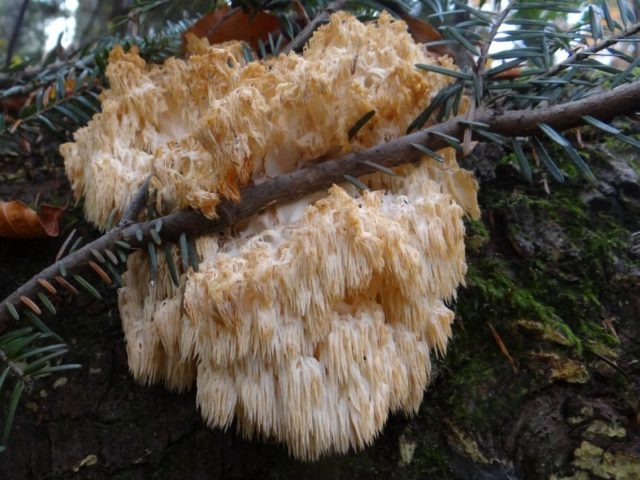
The fruiting body is branched and treelike
Where and how it grows
It grows only in mountainous areas, therefore it is classified as a rare species. It parasitizes on one tree species - fir. You can meet him in 15 places on the territory of the Russian Federation. The maximum number was recorded in the Irkutsk region. It is found in the Krasnodar Territory, the Republic of Adygea, on the territory of the Caucasian ridge, the Crimean Peninsula and in the Amur Region. Abroad, it is also extremely rare. In all regions it is listed in the Red Book.
It grows in untouched forest, on the side of a mountain overgrown with trees, and in the foothills. Bears fruit actively.
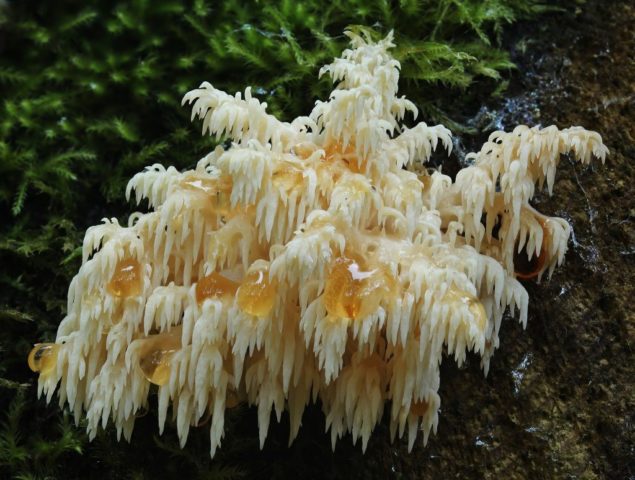
You can meet Alpine hedgehog in July and August
How to cook an alpine hedgehog
The fruiting body does not need to be pre-processed. It is consumed raw. They add to salads, prepare delicious side dishes, soups and various sauces on its basis. Dried fruits are a good seasoning.
Alpine hedgehog can be cooked together with other forest mushrooms. The result is a delicious fried mixture. They add it to all kinds of homemade baked goods:
The harvested crop can be stored in the refrigerator, but no more than three days. After that, the product will have hardness and bitterness. Before being placed in the refrigerator compartment, it is necessary to thoroughly rinse and fill with salted water for a quarter of an hour, then dry with a towel. Transfer to a tightly resealable bag.
You can dry the crop, but in this case the alpine hedgehog will become tough. It can be used after pre-soaking, adding to broth, gravy or soup.
In China, a medicinal broth, ointment, compress and tincture are prepared on its basis.
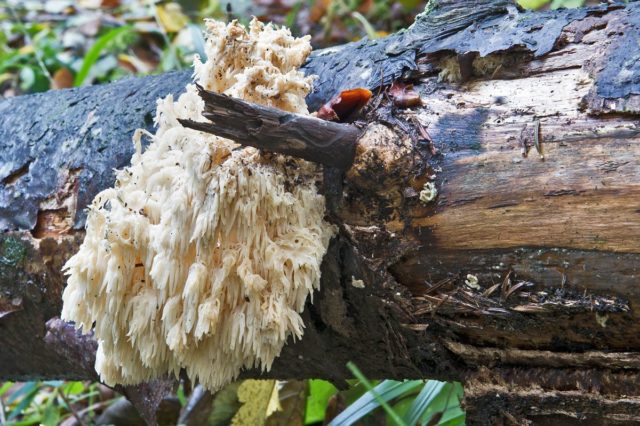
Adult alpine hedgehog
Doubles and their differences
The mushroom can be confused with some other species. It is very similar to the coral hedgehog, which has a darker color and cream shade. Its fruiting period is longer and lasts until early October. This species is not so picky about the choice of wood on which it lives. It grows on almost any type of deciduous tree. Refers to rare and edible.

Coral Hericium bears fruit from July to late October
Also, the fruit body is similar to the crested hedgehog, which is found in Transbaikalia, Amur and Chita regions. It has longer spines of the hymenophore, which grow up to 5 cm. It is white in color. When it dries up or gets old, it turns yellow. Treats edible. The pulp has a pronounced flavor of boiled shrimp. It lives on the trunk of a living oak, in its hollow and on stumps.

The fruiting body has an irregular shape and does not have a stem
Conclusion
Alpine Hericium is a rare unusual mushroom. It is famous for its high taste and does not require preliminary heat treatment.
The most pressing questions and answers to them
Is it okay to give a hedgehog to children?
Hericiums, like other representatives of fungi, are considered difficult to digest and assimilate food. Therefore, you should not give them to children under 5-6 years old.
Is the hedgehog edible if it grows near poisonous mushrooms?
In no case should you collect hedgehogs that are in contact or fused with caps with other mushrooms. Poisonous spores of dubious neighbors can get on the caps of edibles. It is especially dangerous if pale toadstools grow nearby, containing amish poison, which does not dissolve even during heat treatment.
Is it okay to eat black man's feet raw or semi-raw?
In their raw form, they are too bitter, and the variegated hedgehog can cause serious food poisoning, therefore, before using them, it is imperative to boil them for at least 10 minutes and drain the broth.
Hericiums is a generalized name for a group of mushrooms, characterized by the presence of characteristic spines (needles) on the lower part of the cap, but at the same time attributed to different classes, orders and families. According to their taste, they are considered low-grade, therefore they are not cultivated. Despite this, in some European countries, these mushrooms are considered a delicacy and are especially appreciated by French gourmets.
It is possible to meet representatives of this group only in the wild, and some species are so rare that they are protected by the Red Book. Unlike cooking, for pharmacology and medicine, black man's feet are very valuable and are widely used in the treatment and prevention of many diseases.
Evaluation of taste, medicinal properties, benefits and contraindications
A mushroom with a pleasant woody aroma. The pulp gives off spicy notes. As you age, it can taste bitter. Therefore, it is worth preparing exclusively young fruits.
Scientists have conducted experiments on rats to assess the usefulness of the species. Research has shown that Hericium coralloides helps regenerate nerve cells in muscles. During the observation process, the animals did not experience intoxication.
Mushroom extracts are good for the cardiovascular system. Hericenone B, contained in the fruit, has an antiplatelet effect. The substances found in the mycelium, when consumed, lower cholesterol levels. If you use a tincture, then the weight is reduced. It helps fight cancer, Alzheimer's disease. Heals wounds, has an anti-inflammatory effect, eliminates insomnia and depressive conditions.
The benefits of using it in the form of tinctures, extracts, and an independent dish are obvious. Permissible mushroom dosage: 5g / kg body weight. There are no contraindications to oral administration.
Description of species and their photos
All hedgehogs have similar species features, and any of them must be heat treated during cooking.
Edible
- Yellow (lat.Hydnum repandum) is an edible representative of the genus Hydnum of the Ezovik family. It has a yellowish cap with a smooth surface and edges curved downward, which, due to its irregular shape, often grows together with the caps of neighbors. The pulp is whitish, dense and has a pleasant smell. Grows from July to October in deciduous, coniferous and mixed forests.
Hydnum repandum
- White (Hydnum albidum) is practically indistinguishable from yellow. Its cap is slightly lighter and larger in diameter (up to 17 cm), sometimes with blurred grayish or yellowish spots. It prefers to live in damp places, moss cover, deciduous and coniferous trees. But the main condition for its growth is calcareous soil.
Hydnum albidum
- Antennae (Hericium cirrhatum) grows in small tiers on tree trunks and stumps and is listed in the Red Book. Mostly found in mixed forests. Fruiting from late summer to mid-autumn. The hemispherical fruit body consists of several layers, white-cream in color. It can reach a height of 15 cm. It is a bit like climacodon.
Hericium cirrhatum
- The comb (Hericium erinaceus) is protected in many countries. Its fruiting body is irregular in shape and has no legs. Consists of long hanging threads, forming a ball, "beard". For this reason, the people come across the name "grandfather's beard". The pulp is white, soft and fleshy. Distributed in the Khabarovsk Territory, the Amur Region, in the north of China, in the Primorsky Territory, Crimea and the foothills of the Caucasus. Prefers to grow on live or dead oak trunks.
Hericium erinaceus
- Alpine (Hericium flagellum) in appearance is easily confused with coral. The fruiting body is formed by many branches growing from one common short stalk and reaches 30 cm in height. Young specimens are light, whitish in color. Grows in mountainous areas and foothills, especially firs. The peak of the harvest season falls in late summer - early autumn.
Hericium flagellum
- Coral (Hericium coralloides) - the brightest and most beautiful among its relatives, is a Red Book specimen. Its fruiting body has a bushy, branched structure with dense and brittle thorns on the surface. The color is white or cream. The firm and fibrous pulp has a pleasant mushroom aroma. It grows on stumps or in the deciduous canopy of species such as birch, aspen and oak.
Hericium coralloides
Conditionally edible
A few more species of hedgehogs are suitable for eating, but due to bitterness, they require prolonged heat treatment, therefore, they are classified as conditionally edible:
- Red-headed (Hydnum repandum) grows mainly in the wild. Its cap is wavy in shape, has a characteristic reddish-red color and is rather brittle at the edges. The cylindrical leg is weakly attached to the soil, so the mushroom can be easily separated from the ground. Prefers to live in mixed forests, in moss or low grass.
Hydnum repandum
- Variegated sarcodon (Sarcodon Imbricatus) is a rather rare species, found mainly in coniferous forests and in dry sandy soils. Its cap is covered with brown tile-like scales, lagging behind the surface, and the flesh is dense, off-white in color and has a pleasant smell. The smooth stem of a cylindrical shape, 2.5 cm thick and about 8 cm long. The smell of the motley hedgehog is rather sharp and spicy, so I often use it as a seasoning for dishes.
Sarcodon Imbricatus
- The gelatinous pseudo-beetle (Pseudohydnum gelatinosum) is a rather rare specimen, but it can be found in the remains of coniferous and deciduous trees in America, Australia and Northern Europe. The pulp of the mushroom is jelly-like and soft. Although it is considered edible, it is not of any value from a culinary point of view due to its neutral taste.
Pseudohydnum gelatinosum
Inedible
All other representatives of the barnacle mushroom group are inedible, as they are too bitter and may have an unpleasant, pungent odor.These include:
- rough (unkempt);
- felt;
- black;
Black hedgehog
- white-legged;
- striped;
- Finnish;
Finnish mushroom
- the climacodon is beautiful;
- climacodon northern.
North climacodon
Hericium yellow
Synonyms: Hericum notched, Hydnum notched, Dentinum notched.
Specifications:
- Group: aphyllophoric
- Color: yellow
- Info: with spines
This is interesting: How to store cut pumpkin at home - 3 easy ways
Growing at home and in the country
Garden shops sell wooden sticks with spores. In open ground, planted from April to October. They can grow in the greenhouse all year round. The estimated price of a mycelium with spores is $ 4.
The spores are placed in the wood. First, take freshly sawn logs, no shoots. Recommended diameter - 20 cm, length - at least one meter. Submerge the sticks in water, having previously made holes in them (up to 4 cm), measuring 10 cm each time. To sprout more active spores, create a greenhouse effect: wrap the log with foil, take it to a warm, dark room. Watering should be done twice a week.
Note! Before handling spores, wear sterile gloves or treat your hands with an antiseptic. The log can be brought out into the light after the appearance of the mycelium
When the temperature drops, in the winter season, cover with foil. After how many days to collect the fruits of your labor? The first crop appears 6 months after planting. Mushrooms are cut at a young age, without waiting for a change in color and texture
The log can be brought to light after the mycelium appears. When the temperature drops, in the winter season, cover with foil. After how many days to collect the fruits of your labor? The first crop appears 6 months after planting. Mushrooms are cut at a young age, without waiting for a change in color and texture.
False doubles
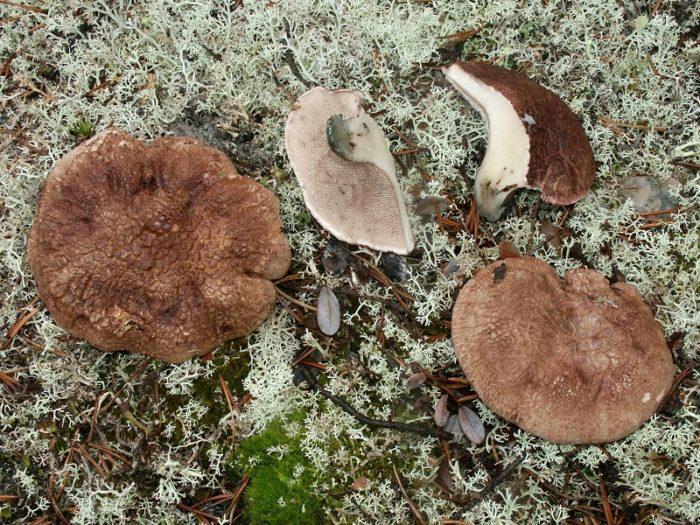 Blue-legged Hericium
Blue-legged Hericium
- Hericium blue-legged (Sarcodon glaucopus) - similar to variegated, but unlike it has a smooth cap and blue color of the leg at the base.
-
Rough Hericium (Sarcodon scabrosus) is a mushroom characterized by a lighter cap and small pressed scales. Does not contain toxic substances, but is of little use for food because of its bitter taste.
-
Sarcodon amarescens is an inedible species. A distinctive feature is a bright bluish-black color of the leg at the base.
-
Yellow Hericium (Hydnum repandum) - similar to variegated after the latter has thoroughly faded in the sun. The mushroom can be eaten and has good taste.
-
The cotton-footed cone mushroom (Strobilomyces strobiaceus) is a rare species. Its speckled cap is identical to Hericium's tartar, but the hymenophore has a tubular structure. Also, despite the outward resemblance, the pineapple mushroom is a representative of the bolet family and forms mycosis more often with deciduous trees. Fruiting earlier
Types of these mushrooms, appearance
Hericium (blackberry, barnyard) is a common name for mushrooms from different families, which got their name because of their unusual appearance. Previously, almost all of them belonged to the genus Hydnum, but the subsequent classification changed this affiliation. Blackberry mushrooms (photo and description are given in the review) look different, there are quite a large number of them.
- Hericium white belongs to the genus Hydnum of the family Yezhovikovs. The mushroom has a white cap of different shades, the diameter of which reaches 10-15 cm. The surface of the cap is dry and plush to the touch. The leg is never empty. The hymenophore consists of a large number of outgrowths similar to the spines of a hedgehog. Spines grow very densely, in adult specimens they easily break, crumble.
- Hericium coral (branched, trellate) visually resembles white or cream-colored sea coral. This unique, extremely rare (edible) species from the genus Gericia (Gericiaceae) is unlike any other mushroom. It grows as a dense bush of fragile thorns on fallen branches and stumps of deciduous trees during the summer, at the beginning of autumn.
- Antennal creolophus belongs to arboreal saprotrophs, grows in the form of hemispherical fruit bodies of white, light cream color, belongs to the genus Gericium. It reaches 15 cm in height and 20 cm in length. The body of the mushroom is fleshy, most often it grows in layers of fan-shaped form one above the other. The surface is covered with white, yellowish spines of various lengths (can reach 1 cm). This edible mushroom can grow up to 1 kg in weight.
- Hericum tiled (variegated) belongs to the genus Sarkodon, the Banker family. This fleshy mushroom sometimes grows up to 20 cm in diameter. The brown cap has a flat or funnel-shaped shape, its entire surface is decorated with circles (concentric) of convex scales sticking up or at an angle. A needle hymenophore is located under the cap. The leg is widened under the cap, becomes hollow with age. The mushroom is edible.
- The lion's mane (combed hedgehog), genus Herzievs, is called by the common people mushroom noodles, grandfather's beard, in Japan it is called yamabushitake, in China - houtougu (monkey head). An exotic, rare mushroom that grows up to 2 kg in weight. It happens white, sandy, pinkish. It is prized as a delicacy (it tastes like shrimp meat).
There are other types of black hairs: reddish-yellow, black, rough, yellow barnacles, devilish, alpine, and others. Not all of the species are edible.





